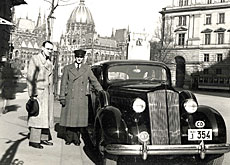Walking the tightrope of Swiss diplomacy

At first sight, a pair of red sports shoes, a Swiss flag with bullet holes in it and an ornate 17th century gold cup may not appear to have much in common.
In fact, they are all objects featured in an exhibition charting almost 400 years of Swiss diplomacy – its successes and failures – at the Swiss National Museum in Zurich.
The exhibition’s title, On a Delicate Mission – Tales of Swiss Diplomacy, sums up the role of Swiss diplomats over the years perfectly, says curator Pascale Meyer.
“Some missions were successful, some weren’t so successful, but most were dangerous, delicate, because nobody was supposed to know and they took place behind the scenes,” Meyer told swissinfo.
One of the first “delicate missions” took place in 1648 when the loose federation of Swiss cantons had no lavish embassies.
Instead it called upon the skills and tact of Johann Rudolf Wettstein, the mayor of Basel, for the tricky task of negotiating the country’s separation from the German empire.
Wettstein was successful and in return he was given a gold cup, which can be seen at the exhibition.
It was not until 1798 that the first official Swiss ambassador was sent to Paris. At the end of the Napoleonic era, a Swiss delegation – of semi-official diplomats – obtained recognition of Switzerland’s independence and “perpetual neutrality” at the Congress of Vienna in 1815.
Slow development
For a long time diplomats were thought to be incompatible with Switzerland’s democratic principles. A small representative network was, however, built up in the 19th century.
“Swiss diplomacy developed slowly. In the 1800s, there were only two embassies and only in the 1950s did the network become much larger,” explained Meyer.
The first international organisations appeared in Switzerland in the late 1800s and in 1863 Henri Dunant founded the International Committee of the Red Cross (ICRC) in Geneva.
Around the same time the Swiss also started offering services such as a court of arbitration after the American Civil War, leading to a rise in the country’s diplomatic reputation.
But this image was severely dented by the two world wars, particularly during the second.
Contrasting attitudes
An illustration of this can be seen in the contrasting cases of two ambassadors. Carl Lutz, Vice-Consul in Budapest, saved around 62,000 Jews through forged letters of safe-conduct.
But Hans Frölicher, the pro-German ambassador to Berlin, played in 1938 a role in German Jews a “J” receiving a stamp in their passports at the Swiss border. The embassy’s flag, complete with Soviet bullet holes, is included in the exhibition.
The wartime shadow was felt again in the mid-1990s, when Switzerland came under fire from the Jewish community over Swiss bank accounts belonging to Holocaust victims.
A special task force was set up to handle the political and legal fallout, headed by diplomat Thomas Borer. A settlement was later reached between the World Jewish Congress and Swiss banks.
Changes
The post-war years saw an effort to rebuild Swiss diplomacy and it has been highly successful through its policy of good offices – mediation between countries – and humanitarian aid.
More recently it has faced competition from other nations. The current foreign minister, Micheline Calmy-Rey has also ruffled a few Swiss feathers with her concept of active neutrality.
“Micheline Calmy-Rey really pushes for being strong on human rights and that is something Switzerland can do,” said Meyer.
It was Calmy-Rey who wore the red sports shoes – complete with Swiss cross – when she crossed the demarcation line between North and South Korea, the first foreign government representative to do so, in 2003.
swissinfo, Isobel Leybold-Johnson in Zurich
The exhibition at the Swiss National Museum runs until September 16, 2007 and is divided into six stations highlighting milestones in the history of Swiss diplomacy.
It includes more than 100 objects, documents and pictures as well as video interviews with current Swiss and foreign ambassadors.
An accompanying photographic exhibition by the Lausanne University of Art and Design details ambassadors and diplomats in Switzerland.
Foreign Minister Micheline Calmy-Rey has pursued an active foreign policy marked by raising the profile of Swiss diplomacy and promoting international law, human rights and peace.
The minister, also currently the Swiss president, has pushed several diplomatic initiatives: the Geneva Accord, an unofficial peace proposal aimed at solving the Israeli-Palestinian conflict; the United Nations Human Rights Council; the Red Crystal symbol of the International Committee of the Red Cross, and her efforts to secure independence for Kosovo.
She has also been campaigning for the increased presence of women in the diplomatic corps. In 2006 there were 376 male diplomats and 71 female diplomats and only 10 of the 116 ambassadors were women.

In compliance with the JTI standards
More: SWI swissinfo.ch certified by the Journalism Trust Initiative














You can find an overview of ongoing debates with our journalists here . Please join us!
If you want to start a conversation about a topic raised in this article or want to report factual errors, email us at english@swissinfo.ch.